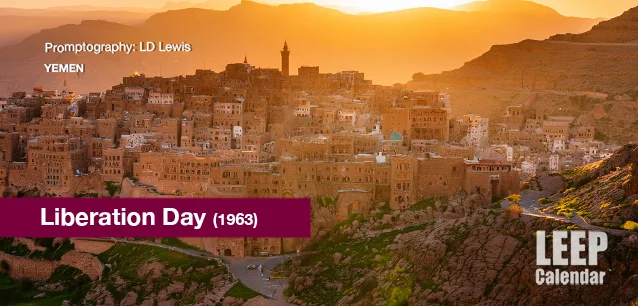 AD
AD
Country
- Africa
- Alcohol, Tobacco & Drugs
- Animals, Fish, Insects & Birds
- Anniversaries
- Australia
- Books
- Brazil & S.America
- Buddhism
Category
- Afghanistan, AF
- Aland Island, AX
- Albania, AL
- Algeria, DZ
- American, Samoa, AS
- Andarra, AD
- Angola, AO
- Anguilla, Al
Event Type
- Daily
- Weekly
- Annual
- Recurring
Duration
- All
- 1 Day
- 2 Day
- 3 Day
- 4 Day
- 5 Day
- 6 Day
Event Type
- Daily
- weekly
- Annual
- Recurring
Event Type
- Daily
- weekly
- Annual
- Recurring
Today is: October 19
Birth of the Baha'u'llah, (1817)
Bridge Day Festival, Fayetteville, (US-WV)
Evaluate Your Life Day, Ntl.
Fetch Day, Ntl.
Gin and Tonic Day, Intl. (2010)
LGBTQ+ Center Awareness Day
Medical Assistants Recognition Day
Oyster Festival US, Leonardtown (US-MD)
Seafood Bisque Day
Sloth Day, Intl
Sweetest Day
Yorktown Day, Virginia (US-VA)(1781)
ACE Week
Baking Week, Ntl. (UK)
Black in Natural History Museums Week
Bone and Joint Action Week, Ntl.
Bullying Bystanders Unite Week
Character Counts Week, Ntl.
Chemistry Week, Ntl.
Coffee Week, (UK)
Felabration (NG)
Food and Drug Interaction Education Week
Foot Health Week (AU)
Forest Products Week, Ntl.
Friends of Libraries Week, Ntl.
Healthcare Quality Week, Intl.
Lead Poisoning Prevention Week of Action, Intl.
Male Breast Cancer Awareness Week, Ntl.
Massage Therapy Week, Ntl.
Newspaper Week (JP)
Pastoral Care Week
Recycle Now Week (UK)
Recycle Week, Ntl. (UK)
Red Bull Tuk Tuk Tournament (LK)
Respiratory Care Week, Ntl.
Retirement Security Week, Ntl.
Rodent Awareness Week, Ntl.
School Safety Week, Ntl (CA)
Schools Week, America's Safe
Sock it to Suicide Week (AU)
Storytelling Festival, Scottish Intl. (UK)
Stuttering Awareness Week, Intl.
Sukkot (J)
Teen Driver Safety Week, Ntl.
Towns Week, Ntl. (PH)
Veterans' Health Week (AU)
Veterinary Technician Week, Ntl.
Wolf Awareness Week, Intl
YWCA Week Without Violence
ADHD Awareness Month
Adopt-a-Dog Month, (AHA)
Adopt-a-Shelter Dog Month
Advertising, Co-op Advertising Awareness Month
Animal Safety and Protection Month, Ntl.
Antidepressant Death Awareness Month
Anxiety and Depression Awareness Month (AU)
Apple Month, Ntl.
Applejack Month
AquaTober
Architecture Month, Archtober
Arts and Humanities Month, Ntl.
Autism Awareness Month (CA)
Bake and Decorate Month, Ntl.
Bat Appreciation Month
Battery Safety Month (Auto)
Bi-national Health Week (US/CA/MX-varies locally)
Big Draw, The
Bilingual Child Month, Celebrating the
Black History Month (UK)
Black Speculative Fiction Month
Blind Month, National Meet the
Blindness Awareness Month
Book Month, Ntl.
Breast Cancer Awareness Month, Ntl.
Bullying Month, Stop, Ntl.
Bullying Prevention Month, Ntl.
Caffeine Addiction Recovery Month
Car Care Month, Ntl. Fall
Caramel Month, Ntl.
Celiac Awareness Month (US)
Cheese Month, American
Chili Month, Ntl.
Chiropractic Health Month, Ntl.
Church Library Month
Church Safety and Security Month, Ntl.
City, Urban October
Class Reunion Month
Clergy Appreciation Month
Co-op Awareness Month
Collegiate Alcohol Awareness Month, Ntl.
Company Culture Month, Global
Computer Learning Month
Contact Lens Safety Month
Cookie Month
Country Ham Month
Country Music Month
Crime Prevention Month, Ntl.
Critical Illness Awareness Month
Cybersecurity Month, Ntl.
Danger Run (US-KY, IN, IL)
Danger Run (US-KY, IN, IL)
Dental Hygiene Month, Ntl.
Depression Education and Awareness Month
Dessert Month, Ntl.
Disability Employment Awareness Month
Diversity Awareness Month, Global
Domestic Violence Awareness Month
Down Syndrome Month, Ntl.
Dyslexia Awareness Month
Eat Better—Eat Together Month
Eczema Awareness Month
Emotional Intelligence Awareness Month
Energy Action Month, Ntl.
Ergonomics Month, Ntl.
Eye Injury Prevention Month
Fair Trade Month
Family History Month
Festival of Penha (BR-RJ)
Filipino American History Month (1587)
Financial Planning Month
Freethought, Month of, Ntl.
Gain the Inside Advantage Month, Ntl.
Gay and Lesbian History Month (1979)
German-American Heritage Month (1683)
Girls Night In (AU)
Go Sober Month (UK)
Golf Month, Australia
Great Cycle Challenge (AU)
Halloween Safety Month
Head Start Awareness Month
Health Literacy Month
Healthy Lung Month
Healthy Workplace Month (CA)
Hearing, Audiology Awareness Month, Ntl.
Hemophilia, Bleeding Disorders Month, Ntl. (AU)
Hog-out Month (US-TX)
Home Eye Safety Month
Indigenous Peoples Month, Ntl. (PH)
Islamic History Month (CA)
Italian-American Heritage Month (1492)
Kartika (H)
Katik (S)
Kitchen and Bath Month, Ntl.
Learning Disabilities Month, Ntl. (CA/US)
Learning and Development Month, Ntl.
Liver Awareness Month, Ntl.
Long Term Care Planning Month
Lupus Awareness Month (UK)
Medical Librarians Month, Ntl.
Medicine Abuse Awareness, Ntl.
Menopause Month, World
Museums and Galleries Month (PH)
Muslim American Heritage Month (US)
National Sausage Month
Non-GMO Month, Ntl.
Organize Your Medical Information Month
Orthodontic Health Month, Ntl.
Pasta Month, Ntl.
Pedestrian Safety Month
Pescatarian Month, Ntl.
Pet Wellness Awareness Month, Ntl.
Pharmacist Month, American
Photographer Appreciation Month
Physical Therapy Month, Ntl.
Pickled Peppers Month
Pink Ribbon Breakfast (AU)
Pit Bull Awareness Month, Ntl.
Pituitary Awareness Month (UK)
Pizza Month, Ntl. (1984)
Polio Awareness Month, (CA/AU)
Polish-American Heritage Month
Popcorn Poppin' Month, Ntl.
Positive Attitude Month
Prenatal-onset GBS Disease Recognition Month
Pretzel Month, Ntl.
Principal's Month, Ntl.
Protect Your Hearing Month, Ntl.
Rabi al-Thani (M)
Reading Group Month, Ntl. (1917)
Rett Syndrome Awareness Month
Riyadh Season 2024 (SA)
Roller Skating Month, Ntl.
STEM Mentoring Month
Sarcastic Awareness Month
School Libraries Month, Intl.
Seafood Month
Seed Gathering Seasons (UK)
Senior's Month (AU-QLD)
Sensory Awareness Month, Ntl.
Shoctober - Defibrillator National Awareness Month (AU)
Spina Bifida Awareness Month, Ntl.
Spinach Lovers Month
Spinal Health Month, Ntl.
Squirrel Awareness and Appreciation Month
Stamp Collecting Month, Ntl
Stop America's Violence Everywhere (SAVE) Month
Substance Abuse Preservation Month, Ntl.
Sudden Infant Death Syndrome (SIDS) Awareness Month
Sunday School Teacher Appreciation Month
Teentober
Tishrei (J)
Turner Prize Exhibition (UK)
U.S.-Mexico Border Health Month
Ultrasound Awareness Month
Unblocktober (UK)
Unblocktober (UK)
Vegetarian Month
Walk To School Month, Intl.
Window Covering Safety Month, Ntl.
Winter Weather Preparedness Weeks (Varies by Location)
Wishbones for Pets (US/CA)
Women's History Month (CA)
Women's Small Business Month
Work and Family Month, Ntl.
Workplace Politics Awareness Month
Youth Justice Action Month, Ntl.
LEEP Calendar
Scroll to explore events active on this date.
Additional Events on LEEP
LEEP INK FEATURES

August is Appropos
A toddler playing in the fountain at a park in Santa Fe, New Mexico—Photo LD Lewis. In August, we live through the Dog Days of Summer. It's hot and often humid, and those ...

September is Sassy
Can you hear that sigh of relief from parents worldwide? Yes! September marks the return of students to school, a global phenomenon. Preparations for the ACT and SATs begin earnestly for ...

OOH LA LA, October
October is the busiest month for events, with 5% more happening than in May, the second most eventful month. Sailing enthusiasts will be glued to the finals of this year's Am...
About Liberation Day in Yemen
Military , Civil Rights
Middle East/West Asia
Ends: Oct 14, 2025
DESCRIPTION:
ENDING BRITISH COLONIAL RULE:
LIBERATION DAY IN YEMEN
The October 14, 1963, revolution in Yemen marks a significant turning point in the country's history. It began the armed struggle against British colonial rule in southern Yemen, particularly in the region known as the Aden Protectorate.
The revolution was ignited in response to growing discontent among Yemenis, who were frustrated with the harsh conditions under British rule and inspired by the broader wave of anti-colonial movements sweeping across the Arab world. The struggle for independence in southern Yemen received further inspiration from the concurrent North Yemeni revolution of 1962, which overthrew the monarchy and established the Yemen Arab Republic.
On October 14, 1963, an armed revolt was launched in the mountainous region of Radfan, led by a group of nationalist fighters. This event is regarded as the official start of the South Yemeni revolution. The uprising quickly spread across the region, with various nationalist groups, including the National Liberation Front (NLF) and the Front for the Liberation of Occupied South Yemen (FLOSY), leading the charge against British forces.
The revolution deployed guerrilla warfare, with Yemeni fighters employing hit-and-run tactics against the better-equipped British military. Despite the odds, the revolutionaries gained significant ground, drawing on widespread popular support from the Yemeni population.
The struggle culminated in the withdrawal of British forces from Aden on November 30, 1967, and the establishment of the People's Republic of South Yemen, which later became the People's Democratic Republic of Yemen. This victory ended over a century of British colonial presence in the region and began a new chapter in Yemeni history.
The October 14 revolution is commemorated annually in Yemen as Liberation Day, a symbol of national pride and resistance against foreign domination. The event is celebrated with ceremonies, parades, and cultural activities that honor the sacrifices made by those who fought for Yemen's independence.
HISTORY OF YEMEN
Yemen's history is as complex as it is ancient. Situated at the southern tip of the Arabian Peninsula, Yemen has been a crossroads of civilizations for thousands of years. The country's strategic location made it a vital center for trade, particularly in the ancient incense trade routes that connected the East and West. Yemen's oldest city, Shibam, often called the "Manhattan of the Desert" due to its impressive mudbrick skyscrapers, dates back to the second century CE and is a UNESCO World Heritage site.
Over the centuries, Yemen has seen various kingdoms and empires rise and fall. The ancient Kingdom of Saba, often associated with the legendary Queen of Sheba, was one of the most powerful in the region, known for its wealth and trade networks. Following the decline of these ancient kingdoms, Yemen became part of various Islamic caliphates and later the Ottoman Empire.
In the 19th century, Yemen's strategic location attracted the attention of European powers, leading to the British occupation of Aden in 1839. The southern part of Yemen remained under British control until 1963 when a prolonged struggle for independence culminated in the withdrawal of British forces and the establishment of the People's Democratic Republic of Yemen (South Yemen). This event is today's celebration.
YEMENI CULTURE
Yemen evolved into two separate states: the Yemen Arab Republic (North Yemen) and the People's Democratic Republic of Yemen (South Yemen). In 1990, the two states combined, forming the Republic of Yemen, although the country has since faced significant internal conflicts and challenges.
Yemen is famous for its rich cultural heritage, which includes traditional architecture, poetry, and music. The country is also known for its coffee production, particularly the Mocha variety, named after the Yemeni port city that was once a major coffee trading hub. Additionally, Yemen is renowned for its historical sites, such as the ancient city of Sana'a, with its unique multi-story buildings adorned with intricate geometric patterns.
Liberation Day reminds us of Yemen's long history of resilience and ongoing struggle for peace and stability. As the country navigates its complex political landscape, celebrating this day symbolizes the enduring spirit of the Yemeni people and their commitment to their nation's future.
VIDEOS
SUPPORTING DOCUMENTS
Currently, this event does not have supporting documents.
ADDITIONAL IMAGES
Currently, this event does not have supporting images.
Where would you like to go now?
 AD
AD
By using this site. You are agreeing to use of cookies. Learn more in our Privacy Policy
/footer-logo.svg)
LEGAL: Excerpts and links may be used, provided that full and clear attribution is given to Jubilee LLC and LEEPCalendar.com, with appropriate and specific direction to the original content (Page URL). Additional documents, embedded videos and additional image rights retained by their creators and are provided to increase understanding of the event or topic.
Jubilee LLC reserves the right to accept or reject inclusion of events in this calendar. The appearance of an event in LEEP Calendar does not imply endorsement of the event, nor the organization championing the event by Jubilee LLC, its stakeholders, customers or subsidiaries. All dates, contact information, URLs, addresses, and information relating to any event, promotion or holiday are subject to change without notice and should be treated as estimated. Jubilee LLC, our stakeholders, customers and subsidiaries cannot warrant accuracy. Users of this application are solely responsible for verifying actual event date with organizers and additional sources prior to committing resources, financial, human or otherwise.


